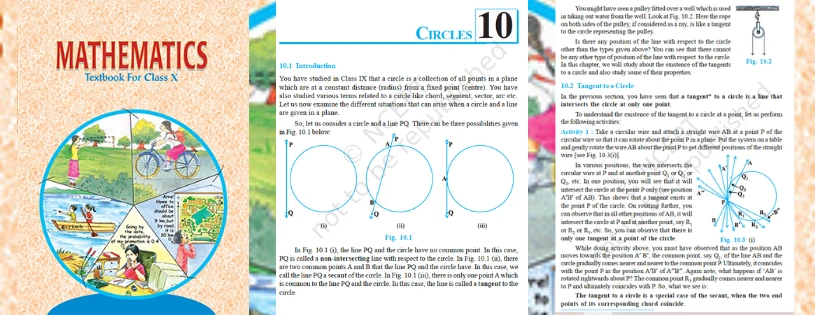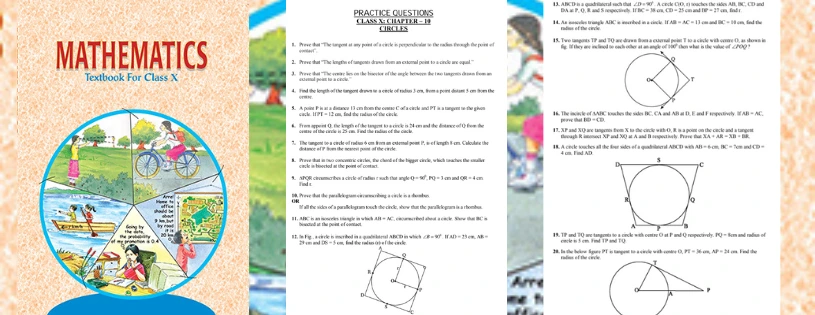Mathematical journey, the chapter on Circles takes center stage, offering a profound exploration into the geometry and properties of this fundamental shape. Join us as we unravel the mysteries of circles, from the basics to advanced concepts, in this captivating Class 10 Mathematics blog.
Circles Unveiled Elevate Your Understanding with CBSE NCERT Download – Your Key to Mastering Class 10 Mathematics
Circle Definition
A circle is a closed two-dimensional figure in which the set of all the points in the plane is equidistant from a given point called “centre”. Every line that passes through the circle forms the line of reflection symmetry. Also, it has rotational symmetry around the center for every angle. The circle formula in the plane is given as:
(x-h)2 + (y-k)2 = r2
where (x,y) are the coordinate points
(h,k) is the coordinate of the center of a circle
and r is the radius of a circle.

Circle Shaped Objects
There are many objects we have seen in the real world that are circular in shape. Some of the examples are:
- Ring
- CD/Disc
- Bangles
- Coins
- Wheels
- Button
- Dartboard
- Hula hoop
We can observe many such examples in our day-to-day life.

How to Draw a Circle?
In maths projects for class 10 on circles, the construction of a circle, all the properties and terminologies are explained in detail. To understand what circles are in simple terms, go through circles for class 10, and also try the following exercise –
-
Take an empty sheet of paper mark a single point on the sheet, somewhere in the middle of the sheet, and name it to point O.
-
Select a random length for the radius, for example, 3 cm.
-
Using a ruler, keep the reference zero mark on point O and randomly mark 3 cm away from point O in all the direction.
-
Mark as many points as you want away from point O, but all of them should be exactly 3 cm away from point O.
If you’ve selected sufficient points, you may notice that the shape is starting to resemble a circle and this is exactly what the definition of a circle is.
Parts of Circle
A circle has different parts based on the positions and their properties. The different parts of a circle are explained below in detail.
- The region is bounded by two concentric circles. It is basically a ring-shaped object. See the figure below.
- Arc – It is basically the connected curve of a circle.
- Sector – A region bounded by two radii and an arc.
- Segment- A region bounded by a chord and an arc lying between the chord’s endpoints. It is to be noted that segments do not contain the center.
- Centre – It is the midpoint of a circle.
- Chord- A line segment whose endpoints lie on the circle.
- Diameter- A line segment having both the endpoints on the circle and is the largest chord of the circle.
- Radius- A line segment connecting the center of a circle to any point on the circle itself.
- Secant- A straight line cutting the circle at two points. It is also called an extended chord.
- Tangent- A coplanar straight line touching the circle at a single point.
CBSE Class 10 NCERT Mathematics Topics for a Strong Foundation (NCERT DOWNLOAD)
| Chapter Name | Circles |
| Topic Number | Topics |
| 10.1 | Introduction |
| 10.2 | Tangent to a Circle |
| 10.3 | Number of Tangents from a Point on a Circle |
| 10.4 | Summary |
I. The Core of Circles: Understanding Basics
Before delving into the complexities, it's crucial to grasp the foundational elements of circles. Students revisit the definitions of radius, diameter, chord, and circumference, laying the groundwork for a deeper exploration.
II. Angle in a Semi-circle: The Art of Half Measures
The chapter introduces the intriguing concept of angles in a semi-circle. Students discover the unique relationship between the angle formed in a semi-circle and its corresponding arc, shedding light on the symmetrical nature of circles.
III. Tangents and Secants: Touching the Boundaries
Circles interact with external lines through tangents and secants, offering students a fascinating study in geometry. From understanding the properties of tangents touching a circle at a single point to exploring the intersecting nature of secants, the chapter unfolds as a geometric masterpiece.
IV. Theorems and Constructions: Building Circles with Precision
Class 10 students delve into the realm of theorems and constructions, where they not only prove geometric statements related to circles but also learn the art of constructing circles with specific properties. These skills empower students to navigate complex geometric scenarios with confidence.
V. Applications in Real Life: The Circularity of Practicality
The blog concludes by highlighting the real-world applications of circle geometry. From designing structures to analyzing planetary orbits, understanding circles is not just an academic pursuit but a key to unlocking the secrets of the physical world around us.
Circle Formulas
We know that a circle is a two-dimensional curve-shaped figure, and the two different parameters used to measure the circle are:
- Area of circle
- Circumference of a circle
Properties of Circles
The important basic properties of circles are as follows:
-
The outer line of a circle is at equidistant from the centre.
-
The diameter of the circle divides it into two equal parts.
-
Circles which have equal radii are congruent to each other.
-
Circles which are different in size or having different radii are similar.
-
The diameter of the circle is the largest chord and is double the radius.
CBSE Class 10 Board Exam Sample Paper

[Previous Year Question Solution Maths Download Button]
[Previous Year Question Solution Science Download Button]
| CBSE CLASS 10 Mathematics Chapters |
| Chapter1: Real Numbers |
| Chapter2: Polynomials |
| Chapter3: Pair of Linear Equations in Two Variables |
| Chapter4: Quadratic Equations |
| Chapter5: Arithmetic Progressions |
| Chapter6: Triangles |
| Chapter7: Coordinate Geometry |
| Chapter8: Introduction to Trigonometry |
| Chapter9: Some Applications of Trigonometry |
| Chapter10: Circles |
| Chapter11: Areas Related to Circles |
| Chapter12: Surface Areas and Volumes |
| Chapter13: Statistics |
| Chapter14: Probability |
| CBSE CLASS 10 Science Chapters |
| Chapter1: Chemical Reactions and Equations |
| Chapter2: Acids, Bases and Salts |
| Chapter3: Metals and Non-metals |
| Chapter4: Carbon and its Compounds |
| Chapter5: Life Processes |
| Chapter6: Control and Coordination |
| Chapter7: How do Organisms Reproduce? |
| Chapter8: Heredity |
| Chapter9: Light – Reflection and Refraction |
| Chapter10: The Human Eye and the Colourful World |
| Chapter11: Electricity |
| Chapter12: Magnetic Effects of Electric Current |
| Chapter13: Our Environment |
| Class 8 |
| Class 9 |
| Class 11 |
| Class 12 |
CBSE Class 10th Downloadable Resources:
| 1. CBSE Class 10th Topic Wise Summary | View Page / Download |
| 2. CBSE Class 10th NCERT Books | View Page / Download |
| 3. CBSE Class 10th NCERT Solutions | View Page / Download |
| 4. CBSE Class 10th Exemplar | View Page / Download |
| 5. CBSE Class 10th Previous Year Papers | View Page / Download |
| 6. CBSE Class 10th Sample Papers | View Page / Download |
| 7. CBSE Class 10th Question Bank | View Page / Download |
| 8. CBSE Class 10th Topic Wise Revision Notes | View Page / Download |
| 9. CBSE Class 10th Last Minutes Preparation Resources (LMP) | View Page / Download |
| 10. CBSE Class 10th Best Reference Books | View Page / Download |
| 11. CBSE Class 10th Formula Booklet | View Page / Download |
Being in CBSE class 10th and considering the board examinations you must be needing resources to excel in your examinations. At TestprepKart we take great pride in providing CBSE class 10th all study resources in downloadable form for you to keep you going.
Below is the list of all CBSE class 10th Downloads available on TestprepKart for both Indian and NRI students preparing for CBSE class 10th in UAE, Oman, Qatar, Kuwait & Bahrain.
FAQ
Q1 What is a circle in short notes?
Ans circle is defined as a two-dimensional figure, which is round in shape where all the points on the surface of the circle are equidistant from the center point is called “P”. The distance from point P to the surface of the circle is called the radius of the circle .
Q2 What are the basic notes of a circle?
Ans The important basic properties of circles are as follows: The outer line of a circle is at equidistant from the centre. The diameter of the circle divides it into two equal parts. Circles which have equal radii are congruent to each other.
Q3 What are the 5 types of circle?
Ans There are three types of circles, namely:
- Tangent Circles: Those two or more circles that intersect each other at one point.
- Concentric Circles: Those two or more circles that have the same center but different radii.
- Congruent Circles: Those two or more circles that has the same radius but different centers.
Q4 Why is it called circle?
Ans A circle is a closed shape formed by tracing a point that moves in a plane such that its distance from a given point is constant. The word circle is derived from the Greek word kirkos, meaning hoop or ring.
Q5 What are the 4 main parts of a circle?
Ans Radius, diameter, center, and circumference–all are parts of a circle.
Leave a Reply